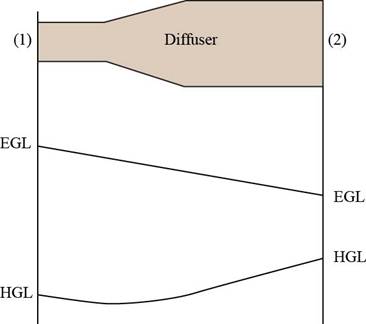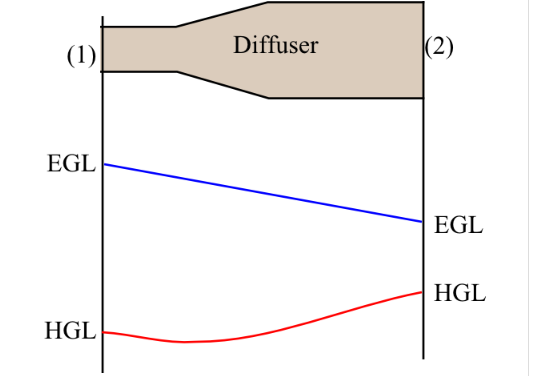
Concept explainers
A diffuser in a pipe flow is basically a slow expansion of the pipe diameter, which slows down the fluid velocity and increases the pressure (the Bernoulli effect). Water at room temperature flows with a volume flow rate of 00250 m3/s through a horizontal diffuser in which the pipe diameter increases gradually from D1= 6.00 to D2= 11.00 cm. The irreversible head loss through the diffuser is estimated to be 0.450 in. The flow is turbulent, and the kinetic energy correction factors at both the inlet and outlet of the diffuser are assumed to be 1.05.
(a) Calculate the pressure difference P2- P1in units of kPa using the energy equation.
(b) Repeat using the Bernoulli equation (ignore irreversible head losses and ignore kinetic energy correction factors-in other words, set the kinetic energy correction factors to 1). Calculate the percentage error in the result due to the Bernoulli approximation. and explain why (or why not) Bernoulli is applicable here.
(c) It may be surprising that the answer to part (a) is positive. i.e., the pressure rises downstream. How is this possible? Explain by calculating the change i n energy grade line EGL and the change in hydraulic grade line .HGL from the upstream to the downstream location. In particular, does EGL go up or down, and does HGL go up or down?
(a)
The pressure difference between outlet to inlet of diffuser.
Answer to Problem 116P
The pressure difference between outlet to inlet of diffuser is
Explanation of Solution
Given information:
The volume flow rate of diffuser is
Write the expression for area of pipe.
Here diameter of section is
Write the expression for velocity.
Here volume flow rate is
Consider inlet section as
Write the expression for energy equation in control volume.
Here, density is
Substitute
Calculation:
Substitute
Substitute
Substitute
Substitute
Refer to table "Properties of saturated water" to obtain density of water as
Substitute,
Conclusion:
The pressure difference between outlet to inlet of diffuser is
(b)
The pressure difference using Bernoulli equation.
The percent error due to Bernoulli approximation.
Answer to Problem 116P
The pressure difference using Bernoulli equation is
The percent error due to Bernoulli approximation is
Explanation of Solution
Given information:
Ignore irreversible head loss, kinetic energy correction factor
Write the expression for Bernoulli equation.
Write the expression for error percentage.
Here, pressure difference using energy equation is
Calculation:
Substitute
Substitute
Bernoulli equation is not applicable here because of pressure head loss and kinetic energy correction factor as greater
Conclusion:
The pressure difference using Bernoulli equation is
The percent error due to Bernoulli approximation is
(c)
The nature of Energy Grade line.
The nature of Hydraulic Grade line.
Answer to Problem 116P
The Energy Grade Line (EGL) decrease from the inlet to the exit and Energy grade Line goes down.
The Hydraulic Grade Line (HGL) increase from the inlet to the exit and Hydraulic grade Line goes up.

Figure-(1)
The Figure (1) shows the nature of Energy Grade Line (EGL) and Hydraulic Grade Line (HGL).
Explanation of Solution
Given information:
Write the expression for net Energy Grade Line (EGL).
Substitute
Write the expression for net Hydraulic Grade Line (HGL).
Substitute
Calculation:
Substitute
Substitute
Conclusion:
The Energy Grade Line (EGL) decrease from the inlet to the exit and Energy grade Line goes down.
The Hydraulic Grade Line (HGL) increase from the inlet to the exit and Hydraulic grade Line goes up.

Figure (1)
The Figure (1) shows the nature of Energy Grade Line and Hydraulic Grade Line.
Want to see more full solutions like this?
Chapter 5 Solutions
Fluid Mechanics: Fundamentals and Applications
- Heat energy is transferred to 1.36 kg of air which causes its temperature to increase from 40" CO 468°C. Calculate, for the two separate cases of heat transfer at (a) constant volume, (b) constant pressure: the quantity of heat energy transferred, (ii) the external work done, (iii) the increase in internal energy. Take cv and cp as 0.718 and 1.005 kJ/kgK respectivelyarrow_forwardA flat circular plate is 500 mm diameter. Calculate the theoretical quantity or heat radiated per hour when its temperature is 215°C and the temperature of its surrounds is 45°C. Take the value of the radiation constant to be 5.67 × 10^11 kJ/m2s K4.arrow_forwardDescribe Atmospheric Air and how it reacts with carbon in combustionarrow_forward
- 0.5 kg of ice at —5°C is put into a vessel containing 1.8kg of water at 17°C and mixed together, the result being a mixture of ice and water at 0°C. Calculate the final masses of ice and water, taking the water equivalent of the vessel to be 0.148 kg, specific heat of ice 2.04 kilkg K and latent heat of fusion 335 kJ/kg.arrow_forwardA condenser vacuum gauge reads 715 mmHg when the barometer stands at 757 mmHg. State the absolute pressure in the condenser in kN/m2 and bars.arrow_forwardSketch and Describe a timing diagram for a 2 stroke diesel enginearrow_forward
- Manipulate the formula for converting temperature from Fahrenheit to Celsiusarrow_forwardDefine Temperature, Pressure, and Absolute Temperature.arrow_forwardAn air reservoir contains 20 kg of air at 3200 kN/m2 gauge and 16°C. Calculate the new pressure and heat energy transfer if the air is heated to 35°C. Neglect any expansion of the reservoir, take R for air = 0.287 kJ/kgK, specific heat at constant volume c, = 0.718 kJFg K, and atmospheric pressure = 100 kN/m2arrow_forward
 Refrigeration and Air Conditioning Technology (Mi...Mechanical EngineeringISBN:9781305578296Author:John Tomczyk, Eugene Silberstein, Bill Whitman, Bill JohnsonPublisher:Cengage Learning
Refrigeration and Air Conditioning Technology (Mi...Mechanical EngineeringISBN:9781305578296Author:John Tomczyk, Eugene Silberstein, Bill Whitman, Bill JohnsonPublisher:Cengage Learning
